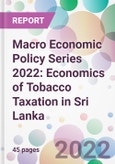As we emerge from a global economic crisis triggered by the pandemic, the current time presents policy makers and business leaders with an opportunity to re-examine some of the perennial issues that have continued to plague the domestic economy. At the frontline of the challenges facing Sri Lanka is that of increasing government revenue by eliminating, or at least minimising the untaxed economy. The consequences of failing to address these leakages in the Treasury will have very significant impacts on the macro economy.
More than ever, policymakers need to address the issue of illicit markets that erode the fiscal revenues of the Treasury. Whilst it is encouraging to note that the Government has accepted and acknowledged the existence of illicit markets in its 2021 budget proposal, policy makers still have ways to go to identify a feasible solution to tackling the menace. Tobacco taxation is a case in point where the politicisation of the issues over many years has resulted in the emergence of a thriving illicit market and a consequent sub-optimal achievement of both the health and fiscal targets.
The report has been compiled using primary data generated from the analyst's consumer survey and all available secondary data from the Government, industry sources and Interviews with Ceylon Tobacco Company PLC as it is the sole licensed manufacturer of cigarettes in Sri Lanka.
The analyst used secondary data from government, and industry sources, as well as primary data generated from the analyst's consumer survey which covers 4 provinces of Sri Lanka.
The purpose of this document is to enlighten readers on the effects of the current tobacco taxation policy in Sri Lanka. It does so by carrying out a comprehensive and detailed treatment of the analysis of tobacco taxation. Using available data for 2021/22, the analyst has carefully and objectively conducted their analysis with a holistic approach that considers tobacco taxation in the context of its entwined relationship with beedi and smuggled cigarettes.
From the consumption side, we have extracted the findings from our primary research into the consumption of illicit tobacco covering the entire island. This survey of smokers, which has given us unprecedented insights, along with available secondary data forms the basis of our analysis.
Who Should Read this Report:
Whether you are a policy maker, academic, industry commentator, or student, you will gain valuable insights from this in-depth research.
Table of Contents
Executive summary
Samples

LOADING...








